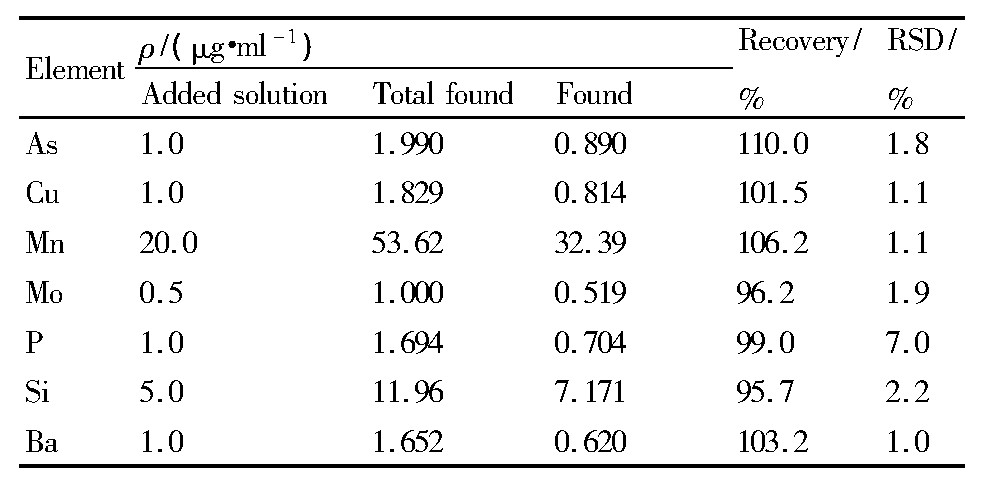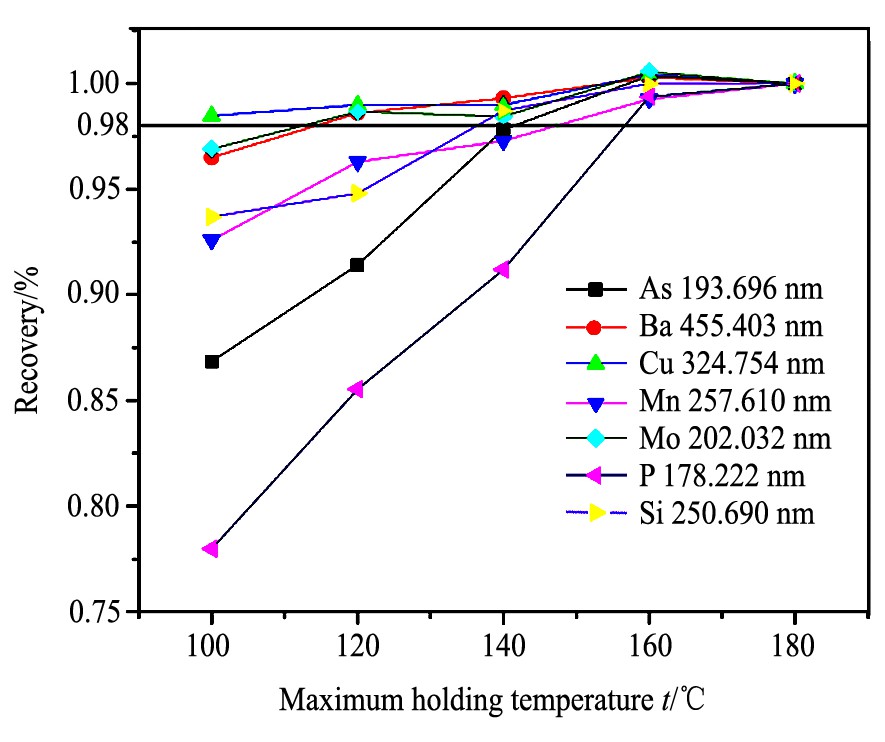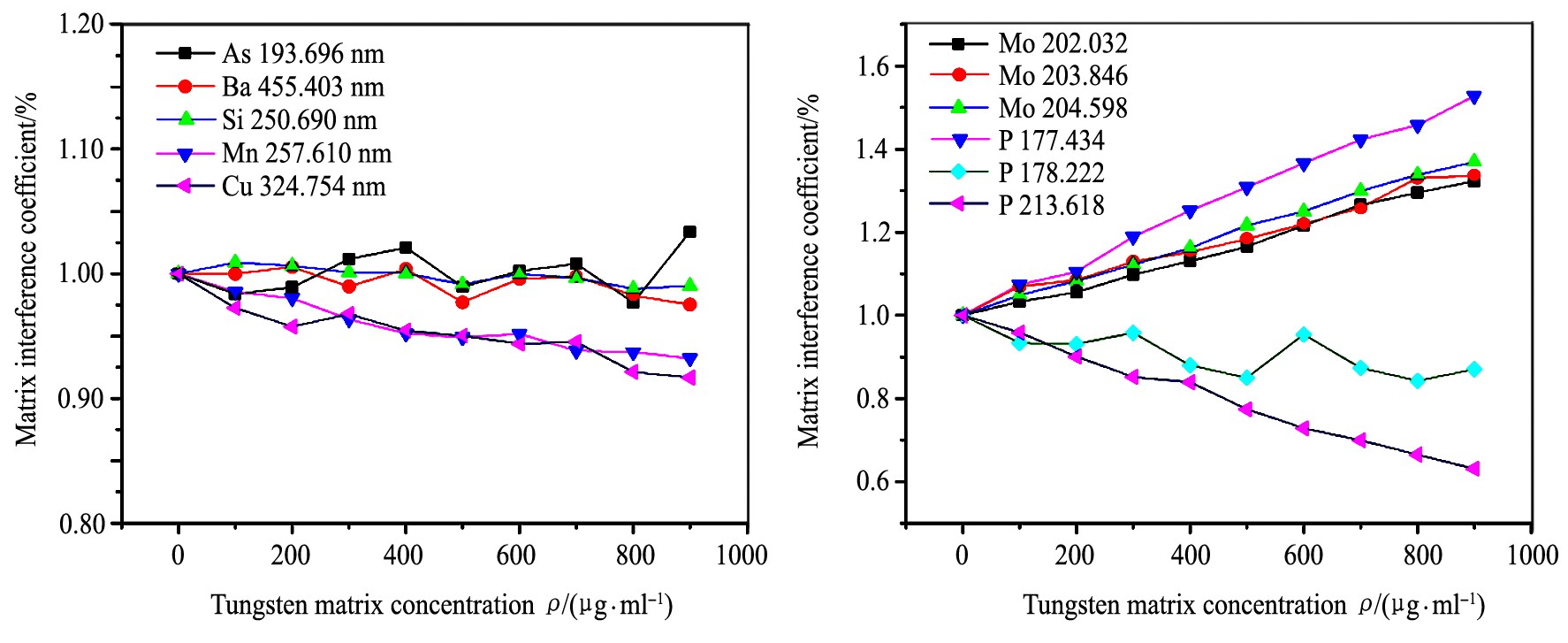网络首发时间: 2017-03-02 14:27
微波辅助酸消解-ICP-OES直接同时测定钨精矿中主要共存元素含量
国家有色金属及电子材料分析测试中心
摘 要:
研究建立了微波辅助酸消解-电感耦合等离子体原子发射光谱法 (ICP-OES) 同时测定钨精矿样品中砷、铜、锰、钼、磷、硅、钡等7种主要共存元素的新方法。试验优化了微波辅助酸消解样品的程序, 研究选择了ICP-OES的最优测试条件和各被测元素的最佳分析谱线。结果表明:采用盐酸+硝酸+氢氟酸 (5+3+2) 混酸作为微波消解酸, 微波消解升温到160℃后保持10 min, 可将样品完全溶解, 溶液清亮, 可用于直接测定, 无需分离钨基体;仪器最优测试条件为射频功率1200 W, 雾化气流量0. 75 L·min-1, 辅助气流量1. 5 L·min-1, 冷却气流量15 L·min-1, 观察高度10 mm, 泵流量2. 0 L·min-1;综合信噪比, 谱线干扰等因素, 选择的最佳分析线分别为As (193. 696 nm) , Cu (324. 754 nm) , Mn (257. 610 nm) , Mo (202. 032 nm) , P (178. 222 nm) , Si (250. 690 nm) , Ba (455. 403 nm) 。本法的检出限为6×10-4~7×10-2μg·ml-1, 加标回收率在95. 7%~110%之间, 相对标准偏差为1%~7%。用本法分析了美国国家标准与技术研究院 (NIST) 的黑钨精矿标样 (SRM277) 和白钨精矿标样 (SRM2430) , 测定结果在标准值±扩展不确定度内。本法流程短、操作简单, 精密度和准确度均能满足钨精矿常规、贸易等分析要求。
关键词:
钨精矿;微波消解;电感耦合等离子体原子发射光谱法;共存元素;
中图分类号: O657.31;TF802.1
作者简介:张煦 (1990-) , 男, 安徽六安人, 硕士研究生, 研究方向:难熔矿物的分析方法研究;E-mail:zhangxu2099@163.com;;*童坚, 教授;电话:13621373619;E-mail:huaxue@grinm.com;
收稿日期:2017-01-10
基金:国家科技部创新方法工作专项项目 (2012IM030500) 资助;
Simultaneous Determination of Major Coexisting Elements in Tungsten Concentrates by Microwave-Assisted Acid Digestion and ICP-OES
Zhang Xu Zhang Diankai Li Tian Liu Ying Zang Muwen Tong Jian
National Center of Analysis and Testing for Nonferrous Metals and Electronic Materials
Abstract:
A new method of simultaneous determination of major coexisting elements such as As, Cu, Mn, Mo, P, Si, Ba in tungsten concentrates using microwave-assisted acid digestion and inductively coupled plasma optical emission spectrometry (ICP-OES) was established. Microwave-assisted acid digestion procedure was optimized, and optimum analysis line and optimum instrument test conditions was selected. The results showed that with mixed HCl-HNO3-HF (5 + 3 + 2) as digestion solution, microwave digestion heated to160 ℃ and holding for 10 min, the solution was clear and suitable for immediate determination, none separation of tungsten matrix was needed; the optimum conditions of the instrument were RF power 1200 W, nebulization gas flow 0. 75 L·min-1, auxiliary gas flow 1. 5 L·min-1, cooler gas flow 15 L·min-1, view distance 10 mm and pump flow 2. 0 L·min-1; considering integrated signal to noise ratio, spectral line interference and other factors, the optimum analysis lines were chosen as: As (193. 696 nm) , Cu (324. 754 nm) , Mn (257. 610 nm) , Mo (202. 032 nm) , P (178. 222 nm) , Si (250. 690 nm) , Ba (455. 403 nm) . The detection limit of this method was 6 × 10-4~ 7 × 10-2μg·ml-1. The recovery for standard addition was 95. 7% ~ 110%, and the relative standard deviation was1% ~ 7%. This method was used to analyze NIST SRM 277 (tungsten concentrate) and SRM 2430 (scheelite ore) . Test results was in the expanded uncertainty of SRMs' s certified or reference value. The method had the advantages of short process, simple operation, high precision and high accuracy, which was suitable for routine and commerce analysis of coexisting elements content in tungsten concentrate.
Keyword:
tungsten concentrates; microwave digestion; inductively coupled plasma optical emission spectrometry; coexisting elements;
Received: 2017-01-10
钨作为一种重要的稀有金属, 用途广泛。钨基合金尤其是研究的热门[1,2]。钨主要由钨精矿冶炼而得。对钨精矿产品进行快速有效的分析测试可以有效地提高生产效率, 保障贸易的顺利进行。
钨精矿化学分析国家标准方法系用原子吸收光谱法、分光光度法、重量法等[3,4]分别测定共存元素。这些方法往往步骤多、流程长, 一种方法只能测定一种元素。而常规的钨精矿中共存元素的测定, 一般采用混酸酸溶体系或者高温下的碱溶处理方式, 之后应用电感耦合等离子体原子发射光谱法 (ICP-OES) 法或者ICP-MS法进行测定[5,6,7,8]。这些样品处理方式, 大多无法将样品溶解完全。且需要将钨酸析出, 取上清液或使钨沉淀后分取滤液进行测定, 操作较为繁杂。
自Abu-samara[9]提出微波消解技术以来, 微波消解技术作为样品的前处理技术有广泛的应用[10,11,12]。该技术具有溶剂使用少、溶解快速、元素损失少、空白低等优点[13]。ICP-OES具有检出限低, 线性范围宽, 可多元素同时分析、干扰小等优点[14], 已广泛应用于复杂样品的多元素同时分析[15,16,17,18]。
本研究则建立了一个微波辅助酸消解-ICP-OES同时测定钨精矿样品中砷、铜、锰、钼、磷、硅、钡等7种主要共存元素的测定方法。该方法减少了分离钨基体的步骤, 避免了分离钨基体可能导致的共存元素损失, 简便了实验步骤。同时, 该方法可以定量检测钨精矿样品中的硅, 较之常规的钨精矿化学分析方法[3,4], 如硅钼蓝分光光度法和二氧化硅重量法, 流程短、操作简单。
1 实验
1.1 主要仪器
电感耦合等离子体原子发射光谱仪Agilent725ES (ICP-OES) ;微波消解仪CEM Mars5。
1.2 试剂
实验用水均为去离子水, 所有酸均为优级纯。
盐酸;硝酸;氢氟酸;锰、磷、硅、钼、砷、钡、铜单元素标准贮备溶液, 1000μg·ml-1 (国家有色金属及电子材料分析测试中心) 。
1.3 仪器工作条件
利用仪器优化程序, 考察了相关参数对被测元素谱线发射强度的影响, 优化了仪器测量参数, 见表1。
1.4 方法
称取0.10 g (精确至0.0001 g) 样品于消解罐中, 用少量水冲洗罐壁, 加入5.0 ml盐酸、3.0 ml硝酸和2.0 ml氢氟酸, 加水至约20 ml。按设定的微波消解程序进行消化。结束后冷却至50℃。转移消化液至250 ml聚四氟乙烯容量瓶中, 定容 (试液中含钨约200μg·ml-1) 。随同样品做空白试验。
2 结果与讨论
2.1 微波消解酸的选择
微波消解中, 常用的消解溶剂有盐酸、硝酸、氢氟酸、磷酸等。试验了盐酸、硝酸、氢氟酸多种组合与用量为消解液, 发现只有采用盐酸+硝酸+氢氟酸的混酸才可将样品分解完全。其中, 盐酸和硝酸混合后会产生强酸性和强氧化性的气体NOCl, 使样品溶解, 同时氢氟酸与钨结合, 避免了钨基体的析出。加水至约20 ml, 可以避免氟离子浓度过高可能导致的钙析出, 同时可以保证每个微波消解罐中的溶液量基本一致。
本实验选择了盐酸+硝酸+氢氟酸 (5+3+2) 的混酸为消解液。消解结束后, 溶液清亮, 可以用于直接测定, 避免了分离钨基体可能引起的粘污与损失。
2.2 微波消解程序优化
ICP-OES分析样品速度很快, 一般2 min内即可完成一个样品多元素的同时测定, 因此样品前处理的时长, 亦即微波消解的时长决定了完成样品分析的时间长短。试验研究了升温时间、保持时间以及保持温度等因素对样品分解的影响。设计了5个不同步骤的微波消解程序优化试验, 如表2。将程序升温至180℃并保持25 min所测得结果视为回收率100%。各元素的微波消解最高保持温度-回收率关系见图1。
表1 仪器工作参数Table 1 Operation parameters for instrument 下载原图

表1 仪器工作参数Table 1 Operation parameters for instrument
表2 微波消解程序优化试验Table 2 Microwave digestion procedure test 下载原图

表2 微波消解程序优化试验Table 2 Microwave digestion procedure test
由图1可知, 随着微波消解最高保持温度的升高, 样品前处理总时间增长, 各元素的回收率增加。当微波消解最高保持温度达到160℃时, 所有元素的回收率均能达到98%以上。而微波消解保持温度过高时间过长会降低微波消解罐的使用寿命, 同时导致更长的冷却时间。
图1 各元素的回收率-微波消解最大保持温度关系图Fig.1 Maximum holding temperature curves of recovery
综上所述, 最终确定微波消解步骤为: (1) 7min内从室温升温到120℃, 保持5 min; (2) 5 min内从120℃升温到160℃, 保持10 min。放置冷却到50℃以下。
2.3 基体干扰试验以及分析线的选择
实际分析的样品中, 钨基体的浓度大约为200μg·ml-1。试验配制了不同浓度的钨基体溶液, 溶液中被测元素的浓度均与样品溶液相近 (As, Cu, P, Ba 1μg·ml-1;Mn 20μg·ml-1;Mo 0.5μg·ml-1;Si5μg·ml-1) 。测定了不同钨基体浓度下被测元素的浓度。将不同钨浓度溶液与不含钨基体的溶液被测元素的测得值的比值作为纵坐标, 钨基体浓度作为横坐标作图。结果如图2所示。
由图2可知, 对于As, Ba, Si 3种元素, 选择的分析线分别为193.6, 455.4, 250.6 nm时, 钨基体对其影响较小。在200μg·ml-1钨基体存在下, 基体干扰均小于2%。
图2 钨基体干扰试验Fig.2 Tungsten matrix interference test
对于Cu和Mn两种元素, 选择的分析线分别为324.7和257.6 nm时, 随着钨基体浓度的升高, Cu和Mn的测定值有降低的趋势。在200μg·ml-1钨基体存在下, 基体干扰分别在2%和4%左右, 基本满足测定的要求。当测定要求较高时, 可以考虑在标准溶液中进行钨基体的匹配。
对于元素P, 其谱线177.4和213.6 nm有比较大的基体干扰, 分别呈上升和下降的趋势, 在200μg·ml-1钨基体存在下, P浓度分别上升和下降了10%。当元素P的分析线选择为178.2 nm时, 其测定值随基体浓度的变化有周期性的变化趋势, 这可能是仪器对于较低波长的测定稳定性较差所导致的。在200μg·ml-1钨基体存在下, 基体干扰约为6%, 基本可以满足测定的要求。
对于元素Mo, 其3条常用谱线均有比较明显的基体干扰。在200μg·ml-1钨基体存在下, 在202.0 nm分析线, Mo浓度升高了5%, 相较其他两条线, Mo的测定更准确。
根据分析线的选择原则, 结合样品组成、被测测元素含量高低以及基体干扰试验中得到的结果, 选择合适的分析线为:As (193.696 nm) , Cu (324.754 nm) , Mn (257.610 nm) , Mo (202.032nm) , P (178.222 nm) , Si (250.690 nm) , Ba (455.403 nm) 。
2.4 校准曲线和检出限
分别移取适量标准储备溶液, 按表3浓度梯度配制标准溶液。按仪器工作条件进行测定并绘制校准曲线。元素的检出限是定量分析的一项重要指标, 按国际理论与应用化学联合会 (IUPAC) 的检出限定义和计算方法, 将空白溶液测定11次, 以信号值的3倍标准偏差对应的浓度为检出限, 见表3。
由表3可知, 所有元素的校准曲线的相关系数均大于0.999, 而且大多数元素, 在0.9999以上。Mo, Mn, P, Si, As, Ba, Cu的检出限分别为0.006, 0.003, 0.07, 0.02, 0.03, 0.001, 0.0006μg·ml-1。
2.5 精密度和准确度试验
取8份同一样品, 按上述方法测定。以结果的相对标准偏差表征方法的精密度。以加标回收率表征方法的准确度。见表4所示。
由表4可知, As, Cu, Mn, Mo, Ba, Si的相对标准偏差均小于2.2%, 精密度良好。但元素P的相对标准偏差为7%, 这可能是仪器对于较低波长的测定稳定性较差所导致的, 基本可以满足测定要求。所有元素的加标回收率在95.7%~110%之间, 说明方法准确度良好。
2.6 方法对比和标样分析
对钨精矿多种共存元素的分析, 常用的样品前处理方式是高温碱溶后酸浸, 再进行钨基体的分离 (或不分离) 之后测定。将本方法测得的数据与碱溶方法测得的数据进行比较, 见表5。两法的测定结果一致, 相差都在5%以内。但是碱溶法步骤复杂, 标准溶液需要加入碱溶空白溶液进行匹配, 同时, 高盐浓度的溶液进样也容易对仪器造成损坏。
目前国内无钨精矿标样。从美国国家标准与技术研究院 (NIST) 购得黑钨精矿标样 (SRM277) 和白钨精矿标样 (SRM2430) 。用本法分析后, 结果见表5。表中列出了标样标准值及其扩展不确定度, 括号内数值为其包含因子。
表3 校准曲线和检出限Table 3 Calibration curve and detection limit 下载原图

表3 校准曲线和检出限Table 3 Calibration curve and detection limit
表4 精密度与准确度试验Table 4 Precision and accuracy test 下载原图

表4 精密度与准确度试验Table 4 Precision and accuracy test
用本法分析NIST标样SRM277与SRM2430, 对于Cu, Mo, P, Si, Mn等元素, 结果均在标准值±扩展不确定度内, 说明本法准确度高。对于元素As, 由于其标准值低于本法的检出限, 没有检出。样品中也没有检出Ba, 标样说明中也没有给出Ba的标准值, 可以认为样品中未含有可检出的Ba。
表5 方法对比和标样分析试验Table 5 Method comparison and SRM analysis test (%, mass fraction) 下载原图

表5 方法对比和标样分析试验Table 5 Method comparison and SRM analysis test (%, mass fraction)
3 结论
研究建立了微波辅助酸消解、不分离主体、直接用电感耦合等离子体原子发射光谱法同时测定钨精矿样品中砷、铜、锰、钼、磷、硅、钡等7种主体元素的新方法。该方法将样品微波辅助酸消解后直接测定, 减少了分离钨基体的步骤。并进行了基体干扰试验, 确定了分析线。各元素的线性相关系数为0.999673~0.999986, 检出限为0.0006~0.07μg·ml-1。测定结果的相对标准偏差在1.0%~7.0%之间, 加标回收率在95.7%~110%之间。与样品碱溶后用ICP-OES测定比较, 测定结果相一致;用本法分析了NIST钨精矿标样, 结果在标准值±扩展不确定度范围内。本方法流程短、操作简单, 精密度和准确度均能满足钨精矿常规、贸易等分析要求, 可用于大批量钨精矿中共存元素的含量分析。
参考文献




